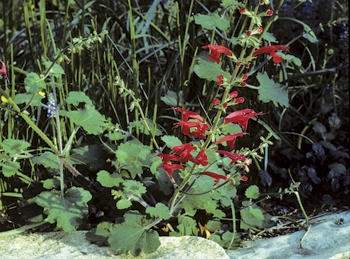We planted the long, green spikes with deep blue flowers two summers ago. The following spring, the plant sent up vigorous shoots and quickly bloomed. Originally, we’d chosen the plant for its striking beauty. Now we had another reason to feel enamored: It came back!
Generally speaking, salvias do that—return full speed in the spring. They’re also drought-tolerant, deer-resistant and very easy to grow. What’s more, their colorful blooms attract hummingbirds. But that’s really all I knew about our showy garden resident: It was a “salvia” that grew alongside other kinds of salvia we’d planted as part of our certified Texas Wildscape.
Detail person that I am, I wanted names. Common and botanical, please. So I decided to do some sleuthing. In my research, I read about salvias and sages. The terms seemed interchangeable. But were they? And what’s the difference, if any? Time to dig deeper and find out.
In one area of our gardens, we grow a bushy green sage alongside bee balm, lemon thyme, lemon verbena, chives and other herbs. Nearby, another bed encircles our collection of ornamental salvias that includes cedar sage (Salvia roemeriana). So, I still wondered, what’s the connection between sages and salvias? Greg Grant, a horticulturist at the Stephen F. Austin State University Pineywoods Native Plant Center in Nacogdoches, offered his … uh … sage thoughts on the perplexing matter.
“All salvias are sages,” he told me, “but not all sages are salvias. For the record, there’s only one true culinary sage.”
More than 900 species compose the genus called Salvia, the largest member of the mint family (Lamiaceae). Add to that several hundred natural hybrids and cultivated varieties, and it’s no wonder we gardeners get dizzy sometimes. Several common traits, however, make it easy to identify a salvia: Look for square stems (which can turn round with age), opposite pairs of leaves (usually hairy) and a corolla—the flower’s colorful tube—that bears two lips of unequal length.
Break off a leaf, then take a whiff. Fragrant, eh? Aromatic salvias have long been valued for their medicinal uses. As far back as the first century, Pliny the Elder, a Roman scientist, wrote about Salvia, a name derived from the Latin verb salvare (to heal). And what about that other name, sage? It traces its roots to medieval England, where herbalists likely took the name from the French word for the same herb, sauge.
In 1597, English botanist John Gerard described several salvia species and detailed their healing powers in his book, The Herball. One was the common garden sage (Salvia officinalis), Grant’s aforementioned culinary sage. Then and now, chefs and gardeners like us grow this shrubby perennial with woolly green leaves as part of a basic bed of culinary herbs. Other sage cultivars, such as tricolor, golden and purple, add a splash of color in the garden. In recipes, they all taste the same.
So what about those sages that aren’t salvias? Grant’s right. I found some: white sage (Artemisia ludoviciana), Jerusalem sage (Phlomis lanata), pitcher sage (Lepechinia fragrans) and Russian sage (Perovskia atriplicifolia), to name a few. In most cases, they’re likely called a sage because they resemble or smell like a salvia. (Jerusalem, pitcher and Russian sage belong to the mint family.)
Dawn Stover, a research associate at the Stephen F. Austin Mast Arboretum, adores growing salvias of all colors and shapes. One of her favorites—Salvia Indigo Spires—boasts deep blue blossoms from April to October. She also loves varieties of Salvia coccinea. We do, too. All of our pink-cream Coral Nymph and crimson Lady in Red salvias reseeded and bloomed within the same growing season!
Last summer, we bought a beautiful cultivar: Salvia x jamensis Sierra San Antonio that bears peach-and-butter-colored flowers. It grows near a white blooming Salvia greggii Stampede Citron, several red shades of Salvia greggii, Salvia farinacea Victoria Blue and the mysterious green-spiked salvia with deep blue flowers.
I was still determined to figure that one out. To speed up the process, I photographed it, then compared the images to similar specimens in my research. Determining its scientific name proved easy. However, settling on a common name made me dizzy. Salvia guaranitica, like many salvias, sages and other plants, has more than one name: blue anise sage, Brazilian sage and black and blue sage. Which one?
Finally, I decided on blue anise sage. After all, I had other things to do. For one thing, I needed to figure out the name for a bushy lantana that we’d just planted in our wildscape …
——————–
Sheryl Smith-Rodgers is a frequent contributor to Texas Co-op Power and wrote about wildscapes in the March 2008 issue.


